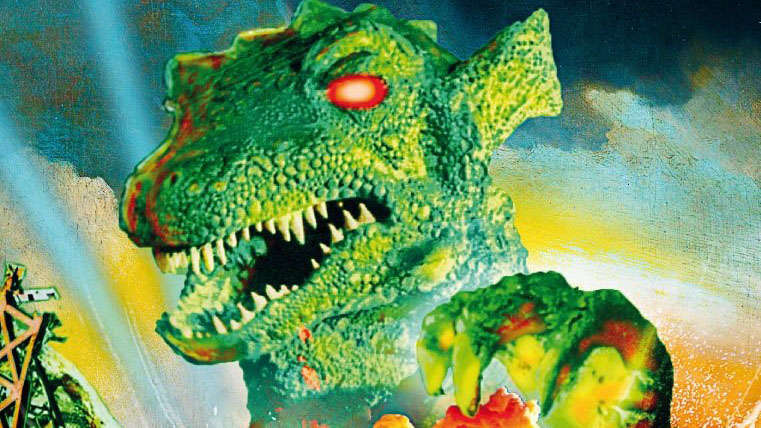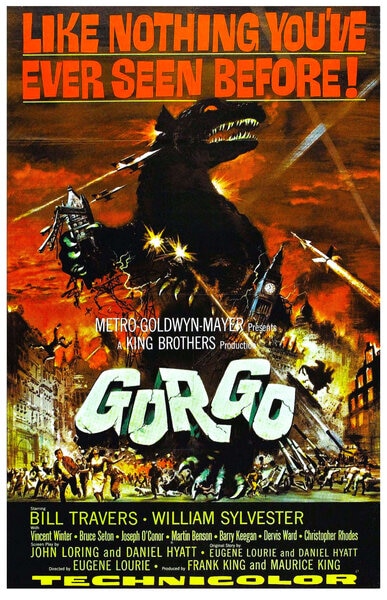Create a free profile to get unlimited access to exclusive videos, sweepstakes, and more!
Godzilla and King Kong are fighting... but it's their British cousin Gorgo's 60th birthday

Part of the fun of a Godzilla vs. King Kong matchup is that it's an international brawl — Japan's most famous kaiju versus America's biggest monster. The pair's first duel in 1962, King Kong vs. Godzilla, was a Japanese production, while their upcoming rematch, Legendary's Godzilla vs. Kong, was organized by the U.S. That movie premieres on March 31, just two days after the 60th anniversary of another, much less famous giant monster who hails from across the pond. Gorgo, the most famous British-Irish kaiju (by default), turns 60 today, March 29.
It's obvious right from the jump that Gorgo is derivative of the much more famous King of the Monsters. The titular beast is a giant dinosaur-like creature who lays waste to a city. His very name, although supposedly inspired by the Gorgons of Greek myth according to the movie, is obviously similar to Godzilla's. King Brothers Productions, the studio behind Gorgo, made the movie because it had seen success in 1957 with the American release of Rodan, another kaiju film from Toho, the studio behind Godzilla.
Gorgo was even originally meant to attack Tokyo, not London, according to author Bill Warren's Keep Watching the Skies: American Science Fiction Movies of the Fifties, but the film's Japanese investors pulled out, leading to a brief period where Paris and Australia were both considered as settings for Gorgo's rampage. (The former was nixed because it wouldn't make sense for Paris to get attacked by a sea monster, the latter because the producers assumed nobody would care if a monster sacked Australia.)
Eventually, thanks to some British studio help, London and a fictional rural Irish isle became Gorgo's stomping ground. In the movie, a bunch of salvagers and treasure hunters encounter a sea monster off the Irish coast. They manage to capture the monster, who they name Gorgo, and they sell him to a circus in London, as one does. However, the orphaned boy they pick up along the way has misgivings about what they've done.
He's right to worry: A scientist studies Gorgo and determines that the 65-foot-tall monster is actually an infant. His 250-foot-tall mother emerges from the water, demolishes some navy ships, and trounces the military. Momma Gorgo smashes through London's Tower Bridge and causes all sorts of destruction before she's able to reach her baby, and the two return to the sea together.
As far as plots go, Gorgo's is pretty threadbare. The human characters are not developed at all, really; the most interesting thing they do is "sell Gorgo to a circus." With the exception of extras in the crowd scenes, there are literally no women in this movie. (Even Gorgo's mother was played by a man in a monster costume.) It's a bland wash of British and Irish masculinity, and the wooden nature of the characters isn't helped by the stiff upper lips.
And yet, Gorgo has a lot going for it — assuming you're just here for the giant monsters, which, let's be honest, is what we're all here for. While the monster was obviously influenced by Godzilla, it's a nifty design. The complex suit sports multiple moving parts, memorable finned ears, and glowing red eyes. Gorgo even had the added benefit of coming out a year before the first color Godzilla film (King Kong vs. Godzilla). The first half of the movie also benefits from detailed miniatures, a consequence of the baby's smaller size. Since Gorgo was only 65 feet tall, the miniatures he smashes were more complex than those a larger-scaled monster would need to stomp on.
Gorgo's best trick plays on this, in a way. After spending the bulk of the film's (brisk) 78-minute runtime with little Gorgo, it's a genuine shock to learn that this monster is actually a baby. His mother, named "Orgo" in a Charleton Comic series that ran for four years after Gorgo's release, feels truly massive as a result of the movie playing bait-and-switch with viewers' sense of scale. "Oh, you thought this was a big monster? No, no, no."
Gorgo further distinguishes itself with its ending. In most monster movies from this era, humankind — either by use of military force or some clever scientific ploy — are able to best whatever beast is attacking. Gorgo ends with Gorgo winning, essentially. Mother and child, reunited, return to the sea. The happy ending (for the monsters, at least) was especially nice for director Eugene Lourie. Almost a decade earlier, he had directed The Beast From 20,000 Fathoms, an extremely influential giant monster movie that boasted stop-motion special effects from the great Ray Harryhausen and a plot that was loosely adapted from a Ray Bradbury story. The Beast From 20,000 Fathoms was a direct inspiration for the original Godzilla, in fact. However, Lourie said his daughter cried when the titular beast, a made-up dinosaur called a Rhedosaurus, dies at the end of the movie. In an interview with Starlog Magazine, Lourie joked that his daughter deserved a writer's credit for her part in shaping Gorgo's ending.
Despite surviving to the end of the movie, Gorgo and his momma never returned for a sequel on the big screen. The movie was successful enough to spawn a novelization and that sequel comic series, though Gorgo's real legacy is something of a cult classic. Gorgo was the subject of the Bots' riffing on an episode of Mystery Science Theater 3000, and footage from the films pops up from time to time whenever a movie or show needs to have a brief glimpse of some old giant monster movie. There's a lot to mock about Gorgo — namely any scene involving humans instead of monsters — but the movie endures among fans of the genre. Despite his clear knock-off origins, Gorgo himself doesn't feel generic, and it's rare to have a monster who isn't Godzilla or King Kong (or Gamera, for the real kaiju fans out there) who leaves a mark.
So, as you prepare to watch Godzilla and Kong battle one another, just remember that Gorgo's sitting on the sidelines. It's been 60 years, so the little guy's probably all grown up now. You know, just in case either of his two more famous peers wants to tag him in.



























